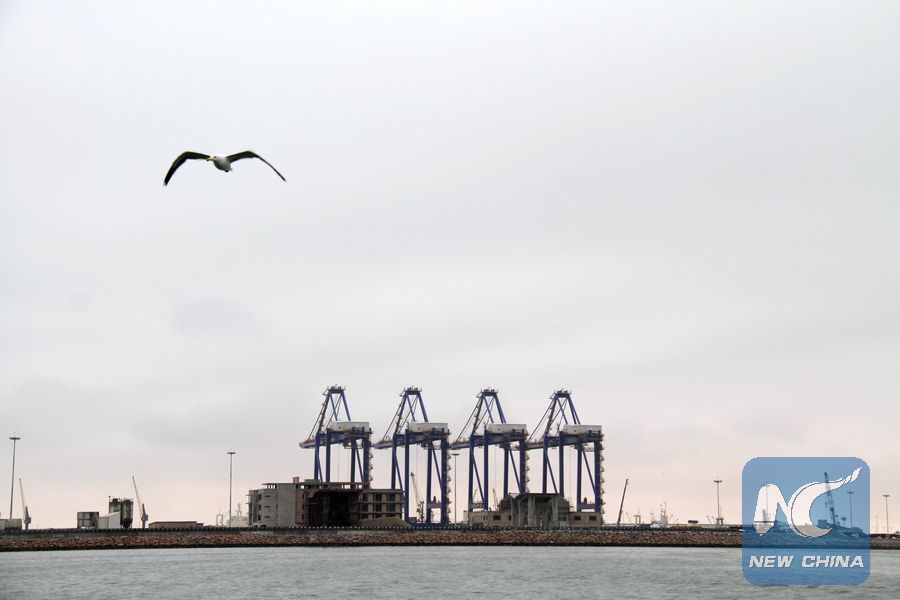
Photo shows the port of Walvis Bay, Namibia. (Xinhua)
WINDHOEK, May 21 (Xinhua) -- At a construction site at the rainless port of Walvis Bay, a rare downpour on Friday grounded all the cranes and bulldozers, but inside the buildings, the action moved on undisturbed as workers busily paved floors and furnished the interiors.
The hustle and bustle is said to be the norm of the construction area of the Namibian port, which is counting down to having a new container terminal and an oil jetty, both being built by a Chinese company.
"Here, work is busy every day, as we make efforts to complete the project in time," said Huang Meng, a chief inspector of China Harbor Engineering Company (CHEC) that is undertaking the expansion of the Atlantic port.
Expected to be completed by the end of this year, the port project, like many other infrastructure developments ongoing in Namibia, lies at the heart of the country's ambition to become a logistic hub in the southern African region.
The expansion will see throughput capacity of the port's container terminals will more than double to 750,000 twenty-foot equivalent units (TEUs) per year. It will also add the first government-controlled oil storage facility in Namibia and a cruise jetty to boost tourism of the scenic African country.
"The type of work we've done here is the first of its kind in Namibia," said Bisey Uirab, CEO of the Namibian Ports Authority, referring to the 40 hectares of lands reclaimed from the sea and the four 79-meter-high ship-to-shore container cranes newly deployed to the port.
Uirab said upgrading the key port is significant to the entire Southern African Development Community (SADC) region, as it will boost import and export of mineral-rich landlocked nations like Zimbabwe and Botswana that are using the port as access, and in the meantime increase Namibia's appeal to global investors.
Moreover, the port construction will spur upgrading of nearby roads and railways, fueling the country's infrastructure boom that the government hopes will create employment and offset the current economic woes caused by low commodity prices.
The momentum is palpable at the port's construction site. "Many people are expecting this new port to be commissioned. It's important to Namibia and we're proud to be part of it," said Liborius Albertze, a Namibian safety inspector who has been promoted from a general worker since the project commenced in 2014.
"Many workers came from far-away places and competed hard to get into the project," said the 27 years old. "No one wants to be idle here."
CHINESE PARTICIPATION
Feng Yuanfei, general manager of CHEC Namibia branch, said undertaking such a large-scale infrastructure project in Namibia is not easy, as the country maintains high standards on work safety and environmental protection.
The company is now keeping a 24-hour monitor on the harbor's water quality and working with a research institute to minimize the project's impact on nearby dolphins, Feng told Xinhua.
Despite the many challenges, a number of Chinese companies like CHEC have managed to gain a foothold in Namibia's infrastructural sector, which Feng attributes to Chinese firms' speed and technical prowess that are winning global recognition.
In the road sector, which transports some 95 percent of Namibia's goods and services, there is also active participation of Chinese companies, said Conrad M. Lutombi, CEO of Namibia's Roads Authority.
Among the major players is China Henan International Cooperation Group (CHICO), which upgraded the Okamatapati-Grootfontein Road that opened last month.
Sun Yanlei, managing director of CHICO Namibia branch, said the company has completed seven infrastructure projects since entering Namibia in 2007, employing 600-800 locals at its peak, compared with a maximum of 60 Chinese employees.
"Localization of our employees not only complies with the Namibia's employment policy, but also raises our efficiency, as importing labors from China is getting more and more expensive," he said.
Lutombi also recognized the Chinese firms' efforts in skill transfer and job creation. "We have had a number of people who have become contractors because of the skill transfer from the Chinese contractors. And that process will continue," said Lutombi.
The prospects now seem brighter for the Chinese investment in Namibia, after the two countries established "comprehensive strategic partnership of cooperation" in March. Namibian President Hage Geingob has also expressed interest in participating in the Belt and Road Initiative, a Chinese proposal to build trade and infrastructure network to link Asia with Europe and Africa.
During his Namibia visit last week, China's top legislator Li Zhanshu also called for the two countries to step up cooperation on infrastructure construction and industrial capacity, which he said will better benefit the people of the two countries.

